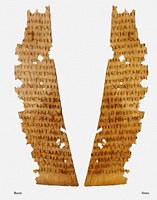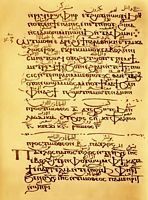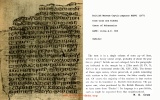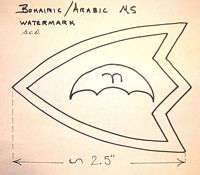ASSORTED IMAGES OF COPTIC
MANUSCRIPTS
Most of the images are of good quality, zoom in to note details or print. Some browsers may not always display these large
megapixel images, in which case, one can try downloading the image.
BE SURE TO "REFRESH" this page!!!|
Our first image is of a very old Bohairic [or proto-Bohairic] text. It is the famous Bala'izah #19. Containing Philippians 3:19 - 4:9 on both recto and verso sides. Parchment, written circa late fourth century. See next images below for a transcription! From Vööbus, this particular image is not very good, but it does reveal some script. For more on the Old Bohairic, see the fourth sample below (P. Mich. 926).
|
 click to view
click to view |
| Transcriptions of the above fragments, in a copy of Paul Eric Kahle's own hand. From: Bala'izah: Coptic Texts from Deir el-Bala'izah in Upper Egypt. Oxford University Press, 1954. With notes. (3 pages). [Note: it is about time biographers quit confusing Paul Eric Kahle with his more famous father Paul Ernest Kahle!]. Paul Eric Kahle was the young brilliant Coptologist who died at a young age. His Bala'izah.... is a must have for any student of the Coptic. | |
|
P. Mich. inv. 926. Another famous papyrus written in Old Bohairic. Though it contains a few portions of Romans and Job, it is part of a writing or school-book exercise book. Date circa A.D. 350, or early fourth per Paul Eric Kahle, Bell, Youtie and Roberts. From Theadelphia, Arsinoite nome, Egypt. Part of a codex, of which 2 double leaves remain. Image borrowed from APIS, University of Michigan, on-line. I enhanced the image for your viewing pleasure! For a discussion of Bohairic one may still refer to Kahle (Bala'izah, pages 250f). We have proof that it existed in pre-fourth century Egypt. Kahle points out that Bohairic was the main dialect of the delta region of Egypt. Consequently, the value of the New Testament Bohairic version is enhanced, it is probably much older than many neo-critics will admit to! The Bohairic version seems to be more stable than the Sahidic version, but future analyses wil prove or disprove this. Even if this is an "exercise book" the script is fairly well written. See if you can find several of the "Old Coptic" characters in the image! In the image next to the sample, we have Elinor M. Husselman's transcription of this leaf, with her notes. Extracted from JNES, 1947, volume 6, No. 3; refer to pages 129-151 for all of its text and transcription by Husselman. [As an aside, 1947 was a good year!]
|
click to view |
|
Found in 1982, and edited by Eitan Grossman and Alain Delattre. Text is of Matthew 26. Suggested date: 450 - 550 A.D. Sixth century per Pasquale Orsini. Parchment from Antinoe. A must read is the editors' PDF file, located at Academia.org. Title: A New Early Bohairic Text From Antinoe - 12 pages. Their observations are a fine sample of good manuscript paleography. |
 click
to view
click
to view |
|
Chester Beatty manuscript Coptic A. Same date and provenance as the "B" above. It contains all of the Pauline epistles. Like most Sahidic manuscripts, Hebrews is placed between II Corinthians and Galatians. Sample image is also from Thompson's work - The Coptic Version of the Acts of the Apostles and the Pauline Epistles in the Sahidic Dialect. Cambridge, 1932. In the image on the right, word separators have been inserted by a modern hand. It contains an apostrophe and other marks of punctuation. As stated above, it is the basis of Thompson's text of the Sahidic and of Mr. Takla's.
|
 click to view
click to view |
|
Codex Jung, the "Gospel of Truth", a non-Biblical manuscript of the Gnostic tradition. Written circa A.D. 325-350, also known as Nag Hammadi Codex 1. Reflects the writings of the Gnostic Valentinus. The image on the far right is an English translation of the sample page. Translation from The Gnostic Scriptures, Bentley Layton, page 255. His text numbering matches the lines of the Coptic text, which is in the Subachmimic dialect (per Layton). Jung image borrowed from Finegan, The Archeology of the New Testament. Any Christian who reads this sort of trash will soon see that it is a perversion of truth. That said, it probably ought to be read, it makes clear the type of opposition early Christians had to deal with. Even today such rubbish is again becoming popular. Note in line 27, the Coptic abbreviation for "cross", this particular abbreviation is available in Mr. Dykes' COPTIC44.ttf font! Note that the page also indicates that whoever (probably Valentinus) wrote this stuff, was aware of the New Testament text, via the numerous allusions just seen on this leaf!
|
click to view |
|
P. Mich. inv. 3521. The Gospel of John in Fayumic Coptic. Papyrus date: circa A.D. 325. Published by Elinor Husselman, 1962. Exists in 29 fragmented folios, of single quire format. Image on the right of the sample (from Husselman's edition) shows Husselman's transcription of this leaf. The gifted E. Husselman produced a fine work here! She correctly supports her use of the term Fayumic (as opposed to "Middle...). She also collates against other Coptic texts. It appears to be a form of text agreeing in part with the Bohairic, then with the Sahidic, perhaps the scribe used both Bohairic and Sahidic versions to compose or create his/her text? Like the Codex Schøyen, above, early Coptic works seem to reflect an unstable environment, rather than to faithfully follow rigidly a single text perceived as Holy. One wonders how concerned they were about introducing changes and foreign elements into their exemplar(s). However, as Husselman shows, there is a clear, broad agreement here of the text of John amongst the various dialects. She does not, however, suggest that this MS may be a translation directly from a Greek exemplar, but rather as stated above, that it rests upon the Bohairic and Sahidic Coptic versions. The other fragments found with this MS, (on Ecclesiastes and the Gospel of John, each in Fayumic) have also been published: Papyrus Michigan 3520 und 6868(a): Ecclesiastes, Erster Johannesbrief und Zweiter Petrusbrief im fayumischen Dialekt. Uwe-Karsten Plisch and Rodolphe Kasser. Berlin, de Gruyter, 2003. |
click to view |
|
Schøyen MS 114. Psalms, in Sahidic on vellum. From the White Monastery, Egypt. Date: circa A.D. 400. Consists of 13 folios, and 6 fragments. Part of an image borrowed from the Schøyen site (above). Beautiful manuscript. Note the unusual line lengths! such line lengths were probably "exported" to Italian scriptoriums, thus the form of these short lines (as seen in Greek/Latin codices Bezae and Claromontanus) probably originated in Egypt [so suggests the webmaster]. This manuscript was at one time in America, but Ferrini sold it.
|
 click to view
click to view |
|
Or. 908. Coptic and Arabic, paper, 221 ff. (f. 13 is more recent), not dated, illuminations (ff. 45b, 93a, 147a) and numerous illuminated capitals and smaller ornaments (e.g. f. 150a). Incomplete copy (beginning and end are missing) of a Coptic liturgy with Arabic translation, written in two columns. Borrowed from the Leiden website - http://www.leidenuniv.nl From the looks of the paper, it is probably not European. The Coptic script, in my estimation, is circa A.D. 1200 - 1400. We have numerous Coptic with Arabic translation manuscripts scattered in many libraries. |
 click to view
click to view |
|
Morgan M 570. Pauline epistles. Sahidic on parchment. Provenance: St. Michael Monastery, Hamouli, [aka Harmouli], Egypt. Date: circa A.D. 850. Manuscript M in the collation apparatus of Herbert Thompson of his Pauline Epistles. Writing shows some word divisions. The decoration, though Egyptian, has some minor affinities with Byzantine artistry. The manuscript has some errors of carelessness, such as homioteleutons, one is seen in this sample page of Romans chapter 1. Part of a hoard of MSS purchased by Pierpont Morgan, fortunately, as they are well taken care of. Facsimile editions are rare, but the Pierpont Morgan library does sell images! |
 click to view
click to view |
|
Morgan M 579, folio 16 verso. Dated: A.D. 823. A MS containing liturgical matter. One may note in the sample image, that supralinear strokes are almost reduced to simple dots. Punctuation is seen, and several interesting markers are seen on the left side of the right column.
|
 click to view
click to view |
|
Two different manuscript samples, but both circa A.D. 1150. #1, illumination of the baptism with John the Baptist, Paris Bibliotheque Nationale. Text appears to be in Bohairic. One should note the use of the uncial form of the Bohairic letter CHAI, it is the typical form in most Bohairic handwritten MSS. Note also several "filled-in" letters, a technique seen often in European Latin MSS. Sample #2, the four gospel evangelists. Illumination from Gospel of Mark, in Smithsonian Institution. Note the bare feet, the prominent Coptic-type eyes, and Greek style robes. Interestingly, Matthew holds open his text as a scroll, the other three are holding codices. Both samples show the strong influence of Greek artistry.
|
click to view |
|
Rome, Vatican, Borg. Coptic 13. Folio 104v. Bohairic with Arabic translation. Date: circa A.D. 1250. Used by Horner in his Bohairic version/edition. Text is II Corinthians 5:11 - 16. [from Vogels] Again note the Bohairic letter CHAI in its usual handwritten uncial form. lots of information seen in this sample as concerns the forms of the Coptic letters seen in this era.
|
 click to view
click to view |
|
Bohairic with Arabic translation. Euchologion. On hand made (laid) European paper. Quarto format. Date: Mr. Hany Takla suggests about 1400, which certainly seems correct. Image #1, recto, beginning of the fifth quire, page 40. Image #2, verso of the above, page 41. Image #3, the same leaf, but backlit to show the watermark. Is about 1/2 of the full mark. Unable to date this watermark! Perhaps is a coat of arms, or a shield?? I was able to reconstruct it as shown in thumbnail #4, shown laying on its side, whereas in the preceding thumb it is shown as positioned (pointing upwards) in the MS.. The inner design may be the full letter "M". This particular manuscript was being sold on E-BAY, page by page! It may never again be re-assembled; a loss perhaps. But then Bruce Ferrini (its owner) needs to pay off several law-suits. He seems to have little choice, and no one seems to be stepping-up with cash in hand to offer to buy the entire book so as to preserve it as a whole book. Such is life! I did save about 50 images of the offerings. Unlike the Green Collection of artifacts, the Ferrini materials are/were accessible to scholars! Dr. Carroll is "in charge" of many MSS in the Green Collection, and hence it will be a long time before some of their treasures are properly published. A case against keeping such documents in private collections. Even if put in a museum, they (Green Collection) cannot be photographed or properly studied, unless you are "tight" with a Dr. Carroll.
|
|
|
Bohairic with Arabic interlinear. Dated: 1357 A.D.. Text is ending of I Timothy with beginning of II Timothy. Manuscript sample borrowed from Tisserant Vatican Coptic 14. (Horner G, Gregory 18). Written on paper in about 350 folios. Described in Horner's Bohairic Version, pages xxxi ff. Contains Pauline epistles, Catholic, Hebrews and Acts. |
 |
| Vienna, Österr. Nationalbibliothek, K 351. Date A.D. 940. Homily on the Angel Gabriel. A nice dated sample, showing two styles of the Sahidic script. [from Till] |  click to view
click to view |
|
British Museum, MS. Or. 7594. Papyrus, Sahidic. Sample shows ending of Deuteronomy, and beginning of Jonah. Manuscript also contains much of Acts. Date: circa A.D. 275 - 325. Published in E. A. Wallis Budge, Coptic Biblical Texts in the Dialect of Upper Egypt. 1912. [from Wurthwein, The Text of the Old Testament, ably translated from the German by the American Bible Society scholar, Dr. Erroll F. Rhodes] According to the late B. M. Metzger, Budge and Thompson both date this MS at A.D. 300-320. Kenyon (Recent Developments in the Textual Criticism of the Greek Bible, 1933, page 35), pointed out that in the binding were found fragments of papyri with Greek cursive script, also dated 4th century. All-in-all, we have here an ancient copy of Sahidic proving the existence of both the Old Testament, and of the New Testament in mature formats in Sahidic in Egypt. Note the spelling of the word "Deuteronomy" with a T- .
|
 click to view
click to view |
|
British Museum, Coptic papyrus - XXXVI, later 167. Canons of Athanasius. Date circa A.D. 600. The added page of comments is by W. E. Crum. Typical of this era for literary Coptic texts is the broad strokes of the Coptic letters, this is the work of a professional scribe.
|
 click to view
click to view |
|
Nag Hammadi codex II, folio 32. Ending of The Apocryphon of John, and the beginning of the Gospel of Thomas. As per most of the Nag Hammadi materials, it was written circa A.D. 350. Sample image borrowed from: The Facsimile Edition of the Nag Hammadi Codices. 1974, part of a fine and costly set of facsimiles; however, one wishes that they were in full color! |
 click to view
click to view |
|
Louvain Coptic 44. Saint Gregory of Nazianze. Date circa A.D. 719. Sample image borrowed from Lefort, Les Manuscrits Coptes de L'Université de Louvain. Louvain, 1940. Note the increasing cursiveness of some of the characters.
|
 click to view
click to view |
|
BM, MS Or. 6782, Death of St. John the Evangelist, folio 5b. On parchment, dated A.D. 990. Second image is an illustration from the same codex. [both from Budge] |
|
| BM, MS. Or 6804 folio 7b. The Book of the Resurrection of Jesus Christ, by Bartholomew the Apostle (apocryphal). Date, circa 10th or 11th per Budge. Parchment. |  click to view
click to view |
| BM, MS 7024, folio 8b. Chrysostom on John the Baptist. Date: A.D. 985. [from Budge] |  click to view
click to view |
|
Morgan, M 617. Folio 1r, Bohairic. Gospel of Luke. Also contains Gospel of John. Date, circa 12th century. 42 leaves remain of an original 88. Note the zoomorphic ornamentation, as well as a headpiece which has some Byzantine characteristics.
|
 click to view
click to view |
|
BM, MS Or. 7021, folio 1a. St. Michael the Archangel. Sample of typical Coptic illumination. (from Budge) |
 click to view
click to view |
















